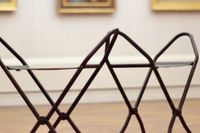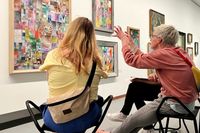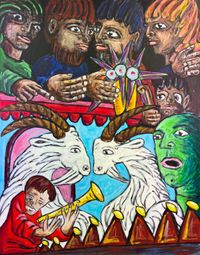How it all started
Everything began with a chair
As a young, aspiring art student, I was convinced: Works of art do not need to be explained; they have their own power and impact. To find out, I visited museums, armed with a chair, and placed it in front of a work of art. I sat down, waited for a long time and hoped that something unusual would happen.
The experience was consistently stunning. With each new encounter, the artworks came to life in a strange yet familiar way - they felt close to me. More than that, they became a part of me, mirroring my questions, feelings and life situation. The artworks became conversational partners with whom I entered into a dialogue in my own way.
Together we see more
When I moved to Berlin, I wanted to share my experience of art with others. I began to lead conversations with small groups in front of works of art. We had a particularly powerful experience in front of a work by Cy Twombly. After a short time, the relaxed, poetic and playful imagery visibly unsettled one of the older participants. In order to relax, we first distanced ourselves from the painting. After a while we moved closer as a group and the following conversation occurred. A young woman said: "The picture fits my current life situation perfectly, I can move from place to place without being tied down by anything," to which the older woman replied almost indignantly: "But you need a goal in life".
I discovered that works of art are not only conversation partners, but also mentors.
They express themselves in different ways - sometimes whispering quietly, sometimes coming forward with confidence and conviction. Works of art reveal what is hidden inside and create a space where you can meet yourself, free from judgement and pressure. The idea of Art Coaching was born.
The conversation is the work of art
Art Coaching is based on the experience and conviction that creative processes and interaction with works of art expand our self-image and sharpen our perception.
This understanding provides the ideal basis for a coaching situation. The unique dynamic of the dialogue between artwork, coach and coachee creates a tangible, very substantial space. "The dialogue itself is the real work of art," a participant once said to me.
Practice and impact
How does Art Coaching in front of art work? Together, my coachee and I stand in front of a work of art that he or she has chosen to suit the coaching issue. We observe it closely, study the details and discover connections. For example, in the painting "Theatre Scene", we would start by observing the various elements such as figures, colours and composition.
Direct perception and reflection as a first step towards the painting not only promotes a deeper understanding of the artwork, but also reflects your own thoughts, feelings and the coaching theme itself.
In the second step, we link the image more closely to the coaching question. For example, my coaching question might be "How do I manage to stay calm in my leadership role, especially when I am being critically observed? The image offers a variety of suggestions as to how I can successfully manage such a situation. For example, the trumpeter or the two rams meeting in a friendly way could represent people who support me in challenging moments. Through the dialogue with the artwork, coaching becomes a space for finding creative solutions.
The place makes a difference
My experience that art is seen and appreciated through the environment in which it is shown has been a major influence on my work. A museum or gallery is therefore not only a space for presentation, but also a powerful place for self-discovery and personal development. In this sense, coaching in front of art usually takes place in a museum or gallery.
Coaching in front of art is more
Engaging with works of art is not just a method of personal and professional development; it is a way of life. The encounter with art is so valuable because it opens our eyes to stay curious and constantly question ourselves. We are at our destination and change with it. As human beings, we are able to see the beauty in the cracks in our lives; as Leonard Cohen describes in a song: "There's a crack in everything / That's where the light comes in.


